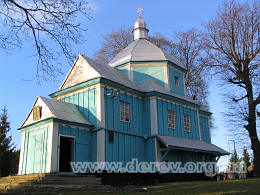 home |
|
Volyn region Horokhiv district BorochycheBrany Kutriv Kvasiv Pidberezzya Rzhyschiv Shklyn` Smolyava Vil'khivka Ivanychi district BuzhkovychiKolona Nyzkynychi Staryj Poryts'k
Kamin'-Kashyrs'kyj Hrudky Kachyn Khoteshiv Nuyno Osivtsi Verkhy Vyderta Zapruddya Kivertsi district LypneMetel'ne Olyka Omel`ne Prylutske Zalisoche Kovel' district Kovel'Drozdni Hishyn Holoby Pohin'ky Lokachi district SirnychkyLuts'k district HorodyscheNesvich Shepel' Smolyhiv Usychi Lyubeshiv district BirkyVelyka Hlusha Lyuboml' district Lyuboml'Zgorany Manevychi district KarasynTroyanivka Ratne district SamaryTur Zabolottya Zalisy Zamshany Zdomyshel' Rozhysche district DorosyniHorodyni Pozharky Rudka-Kozyns'ka Schuryn Shats`k district PischaPul`mo Stara Vyzhivka district Stara VyzhivkaTuriys'k district LukivNovosilky Osa Turopyn
Volodymyr-Volyns'kyj Ludyn |

|
|
Vil'khivka Vil'khivka, Horokhiv district, Volyn' region Show on map
| По дорозі з Вільхівки на сусідню Ярівку, на пагорбі понад річкою зберігся напівзруйнований вітряк (за спостереженнями Р. та С.Линників, квітень 2007 р.).
| ||||||
[an error occurred while processing this directive]



![View from north west [MTA, v. 2, p. 67]](pga2_177.jpg)
![Plan [MTA, v. 2, p. 67]](pga2_178.gif)
